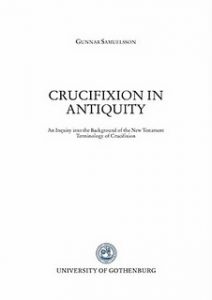 Evangelical Textual Criticism discusses the successfully defended thesis of Gunnar Samuelsson that the ancient textual evidence fails to support our image of Jesus dying on a cross. From the ETC site:
Evangelical Textual Criticism discusses the successfully defended thesis of Gunnar Samuelsson that the ancient textual evidence fails to support our image of Jesus dying on a cross. From the ETC site:
Last Friday Gunnar Samuelsson successfylly defended his thesis “Crucifixion in Antiquity: An Inquiry into the Background of the New Testament Terminology of Crucifixion” at Gothenburg University (supervisor Samuel Byrskog).
Abstract
This study investigates the philological aspects of how ancient Greek, Latin and Hebrew/Aramaic texts, including the New Testament, depict the practice of punishment by crucifixion. A survey of the ancient text material shows that there has been a too narrow view of the “crucifixion” terminology. The various terms are not simply used in the sense of “crucify” and “cross,” if by “crucifixion” one means the punishment that Jesus was subjected to according to the main Christian traditions. The terminology is used much more diversely. Almost none of it can be elucidated beyond verbs referring vaguely to some form(s) of suspension, and nouns referring to tools used in such suspension. As a result, most of the crucifixion accounts that scholars cite in the ancient literature have to be rejected, leaving only a few. The New Testament is not spared from this terminological ambiguity. The accounts of the death of Jesus are strikingly sparse. Their chief contribution is usage of the unclear terminology in question. Over-interpretation, and probably even pure imagination, have afflicted nearly every wordbook and dictionary that deals with the terms related to crucifixion as well as scholarly depictions of what happened on Calvary. The immense knowledge of the punishment of crucifixion in general, and the execution of Jesus in particular, cannot be supported by the studied texts.
The same blog site offers contact details for purchasing the dissertation, and additional notes from its concluding chapter. There is also a discussion of the archaeological evidence.
If you enjoyed this post, please consider donating to Vridar. Thanks!

Given the nearly 900 years of written text, from the time of Homer to 200C.E., that Samuellson has reviewed, it is evident that “stauros” cannot be considered Crucifixion. Removing the Crucifix from Christian worship is also in alignment with 1 John 5:21,”Little children, guard yourselves from idols.”
What worries me about doing away with the cross is what is left to replace it. Remove that cross-beam and we are left with a pillar that is said to lack a baculum.